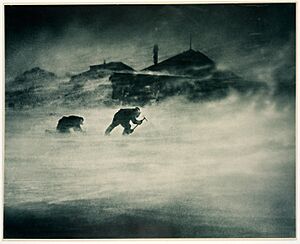Cape Denison facts for kids
Cape Denison is a rocky point located in Antarctica. It sits at the top of Commonwealth Bay in an area called George V Land. This special place was found in 1912 by an expedition led by Douglas Mawson.
Mawson's team, the Australasian Antarctic Expedition (1911–14), named the cape after Sir Hugh Denison. He was a supporter of their journey from Sydney, Australia. Cape Denison became the main base for Mawson's expedition. Mawson famously called it "the windiest place on Earth" because of the incredibly strong katabatic winds that blow there.
Contents
A Special Historic Place
Cape Denison is a very important historic site. It includes Mawson's Huts, which were the buildings used by Mawson's team. The area also has Boat Harbour and many old items found in its waters.
Because of its history, Australia suggested that Cape Denison be named a Historic Site or Monument (HSM 77). This was agreed upon by the countries involved in the Antarctic Treaty System.
Antarctica's First Aeroplane
Cape Denison was home to the very first aeroplane ever brought to Antarctica. This plane, called the Air-tractor sledge, arrived in 1912. However, it was damaged before it even got to Antarctica, so it never actually flew there.
The aircraft was a Vickers R.E.P. Type Monoplane. It was the first type of plane built by the company Vickers. Mawson's team tried to use it as a "propeller driven snow tractor" for a short time. But the cold weather caused its engine parts to stop working, and it had to be left behind.
Finding a Piece of History
On New Year's Day in 2010, something exciting was found at Cape Denison. A carpenter on a new expedition discovered small pieces of the plane's body. These pieces were about 150mm long and were found in the harbour during a very low tide.
The pieces were from the back part of the plane. Mawson's team had tried to make a special metal "ice rudder" from them. This new rudder was meant to replace the original one, which didn't work well at slow speeds. The original rudder is now kept in Mawson's Hut at Cape Denison. The ice rudder is in Tasmania, Australia.
Scientists believe more parts of the plane might still be buried under the ice near Mawson's Huts. The ice is about 3 meters deep, and the parts are thought to be about 30 meters from the harbour's edge. Plans to dig up the site have been delayed several times. This was due to problems with supplies and a giant iceberg B9B. The iceberg blocked the French supply ship L'Astrolabe from reaching Commonwealth Bay.
Adélie Penguin Colony
Cape Denison used to have a very large group of Adélie penguins. There were once around 150,000 penguins living there!
In 2010, a huge iceberg got stuck near the colony. This made it very hard for the penguins to reach the sea to find food. Many penguins struggled to survive. By 2013, only about 10,000 penguins remained.
Scientists studied the impact of the iceberg, called B09B. They found that the penguins now had to travel about 65 kilometers (about 40 miles) between their breeding areas and the sea. Fewer penguins returned to breed, and many chicks did not survive. While many chicks and eggs were lost, it's important to know that most adult penguins did not die because of the iceberg.
This iceberg event mainly affected the Adélie penguins in the Commonwealth Bay area. Millions of other Adélie penguins living around the rest of Antarctica were not impacted.
The 102-hectare area where the penguins live has been named an Important Bird Area (IBA) by BirdLife International.
See also
 In Spanish: Cabo Denison para niños
In Spanish: Cabo Denison para niños




